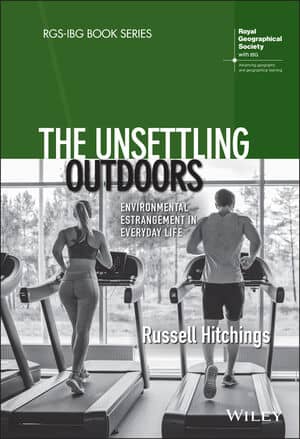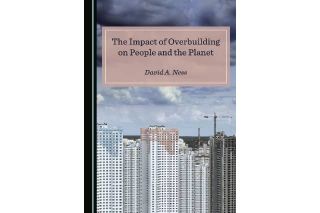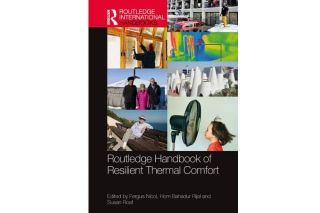
www.buildingsandcities.org/insights/reviews/unsettling-outdoors-environmental-estrangement.html
The Unsettling Outdoors: Environmental Estrangement in Everyday Life
By Russell Hitchings. RGS-IBG with Wiley, 2021, ISBN: 978-1-119-54915-4.

Sarah Royston reviews this book about the intersection between urban lives and green spaces.
From burgeoning research on nature-deficit disorder (Louv, 2005), to the cultural phenomenon of the Lost Words project (Macfarlane and Morris, 2017), awareness is growing of environmental estrangement in modern urban lives. Despite extensive evidence on the benefits of outdoor experiences for wellbeing, and for engagement with environmental issues, we seem to be spending less time in contact with the natural world. In his fascinating new book, Russell Hitchings argues that particular patterns of living are systematically reducing city-dwellers' engagement with green spaces. Through four case studies, exploring how people work, exercise, garden and keep clean, he shows how daily routines increasingly alienate us from outdoor experiences.
A key contribution of the book is in forging links between geographies of nature and theories of social practice, so as to explore the kinds of (dis)connection with outdoor environments that arise through the performance of various everyday activities. Hitchings not only documents the "extinction of experience" (Pyle, 1993), but reveals the insidious and systematic ways in which specific patterns of work and leisure are effectively editing greenspace out of urban lives. The in-depth focus on mundane routines enables the analysis to go beyond generalised statements about estrangement from nature, to examine specific dynamics of forgetting, avoiding, succumbing and embracing that play out in particular contexts. However, the overall implication of the book seems to be that forgetting and avoiding are the most powerful of these, with an embracing of nature only observed as a temporary disruption to normality within the short timeframe of a music festival.
Reflecting on Hitchings' four case studies, one can see recurring spirals of loss and degradation, not just in experience and interest, but in vocabularies, norms and skills. In a revealing example, when asked to describe their gardens, some participants lapsed into a bemused silence; the book highlights narrowing repertoires of speech, thought and action. One disturbing finding concerns a perception that engaging with nature is eccentric or weird, with an "outdoor alibi" (p63) (such as running an errand) needed in order to legitimise such peculiarity. Some office-workers were so imprisoned by the interlocking constraints of work cultures and temporalities that they reported only a vague awareness of the present season and weather. Meanwhile, there are associated losses in skills, such as know-how for adaptive comfort that responds to the vagaries of outdoor environments. The picture painted by this book - a collective sleepwalk into a lifeless concrete world - can certainly be described as unsettling.
More
widely, the book opens up exciting questions about how nature and outdoor
experience can be understood within a practice-theoretical analysis. For example,
Hitchings' analysis focuses mainly on tensions between practices and the
outdoors, rather than on 'positive' entanglements. The four dynamics that he
identifies are compelling in their own right, but also serve as an invitation
for further research: we might wonder what kinds of nature-engagement are
demanded by other forms of practice, for other practitioners. In what ways do
everyday routines facilitate, say, nurturing; stewarding; observing; or creatively
engaging with green spaces? In what ways might such routines be fostered and
supported?
The book is also remarkable in its methodological contribution, serving as a model for qualitative research that takes social practice seriously: reflexive, opportunistic, unapologetically fascinated by the mundane, and fundamentally respectful of participants' expertise in their own lives. Hitchings tackles critiques of talk-based practice research head-on, offering a carefully-reasoned justification of interview methods: not claiming that they give an objective 'window' onto participants' lives, but rather understanding talk itself as practice, and attending to real-life ways of speaking in specific moments, and what they can (and cannot) tell us about the speaker's experience.
Drawing on several years of field research and over 180
interviews, Hitchings is unafraid
to provide the kind of messy detail that journal papers often skim over.
Through frank accounts of the methodologies used, he unsettles notions of what
an interview is and should be. The data collection involved a mingling of observation
and participation, along with interview-conversations that were often responsive,
informal and mobile, including 'running interviews' with runners. The book
offers particularly valuable advice for those researching 'banal'
subjects, which can be challenging to study. It illustrates how researchers
might use instances of disruption to illuminate the normal, how photo-taking can
stimulate discussion of everyday environments, and how different question
framings open up new ways of thinking. The analysis pays attention to what is
unspoken, dodged
or deflected, and the strategies deployed, with thoughtful reflection on
details such as use of the passive voice and laughter. The result is not only a
rich set of findings, but a hugely valuable resource for students and other
researchers interested in applying creative qualitative approaches to everyday
life.
The book
raises significant challenges for professionals involved in urban policy,
planning and design. Critically, it shows how promoting outdoor experience is
much more than an issue of provision of urban green spaces. Nor is it simply a
matter of raising individuals' awareness of green-space opportunities or
benefits. This analysis reveals the importance of considering outdoor
experience in the context of the many intersecting routines that make up city-dwellers'
lives. Arguably, one implication of this is to massively broaden the scope of
what we consider to be a green-space policy or intervention (as has been
demonstrated in other fields, e.g. by Royston et al., 2018). Building on work
linking active travel with green-space (e.g. Le et al., 2018) we might think of
urban travel policies as green-space policies, and ask how they act to obstruct
or facilitate outdoor experiences. Going further, how might green-space
engagement be supported by interventions aimed at workplace cultures or timings
of the working day?
Hitchings' analysis challenges decision-makers and planners to think about designing for lives that include outdoor experience as a matter of routine. What might such ways of life look like: not just in terms of space and infrastructure (though these are important) but in time, in skills, in understandings of what is normal? For example, as well as considering the size of private gardens, we might ask whether people have opportunities to develop the practical skills and vocabulary to engage with the spaces they have. This might lead us to think about supporting community gardens where such skills can be shared. If just 'being in nature' is seen as eccentric, we might think about fostering different 'legitimate' forms of outdoor practice. For example, could local authorities provide or support outdoor exercise classes (and suitable dog-free spaces for them)? Architects might take into account the need to create time-space for acceptable outdoor experience within work environments, for example, providing 'outdoor meeting rooms' or 'outdoor desks' using office roofs or courtyards.
For
researchers, Hitchings highlights interesting topics for further study in the
field of urban green-space, including the roles of weather and climate; technology
and time; and dirt and disruption. He also draws attention to the influence of
intermediaries such as garden-designers, highlighting an underexplored area within
green-space research (which mostly focuses on residents). This insight also represents
an invitation to these professionals themselves: to recognise that they have a
key role to play as makers and shapers of outdoor practices. Ultimately (and as
the COVID pandemic has powerfully shown) routines are never fixed, and can be
disrupted in all sorts of ways.
With
a down-to-earth style, Hitchings' work embodies urban geography at its best -
rooted in creativity, reflexivity, theoretical insight without dogma, and a
deep attentiveness to the entanglements of human and beyond-human worlds. The
book is not only a valuable resource for researchers and students in geography,
planning and the built environment, but also a fascinating and engaging read.
References
Le, H.H.K, Buehler, R. and Hankey, S. (2018). Correlates of the built environment and active travel: evidence from 20 US metropolitan areas. Environmental Health Perspectives, 126:7. https://doi.org/10.1289/EHP3389.
Louv, R. (2005). Last Child in the Woods: Saving our Children from Nature-Deficit Disorder. New York: Algonquin Books.
Macfarlane, R. and Morris, J. (2017). The Lost Words. London: Hamish Hamilton.
Pyle, R.M. (1993). The Thunder Tree: Lessons from an Urban Wildland. Boston: Houghton Mifflin.
Royston, S., Selby, J. and Shove, E. (2018). Invisible energy policies: A new agenda for energy demand reduction. Energy Policy, 123: 127-135. https://doi.org/10.1016/j.enpol.2018.08.052.
Latest Peer-Reviewed Journal Content
Acceptability of sufficiency consumption policies by Finnish households
E Nuorivaara & S Ahvenharju
Key factors for revitalising heritage buildings through adaptive reuse
É Savoie, J P Sapinski & A-M Laroche
Cooler streets for a cycleable city: assessing policy alignment
C Tang & J Bush
Understanding the embodied carbon credentials of modern methods of construction
R O'Hegarty, A McCarthy, J O'Hagan, T Thanapornpakornsin, S Raffoul & O Kinnane
The changing typology of urban apartment buildings in Aurinkolahti
S Meriläinen & A Tervo
Embodied climate impacts in urban development: a neighbourhood case study
S Sjökvist, N Francart, M Balouktsi & H Birgisdottir
Environmental effects of urban wind energy harvesting: a review
I Tsionas, M laguno-Munitxa & A Stephan
Office environment and employee differences by company health management certification
S Arata, M Sugiuchi, T Ikaga, Y Shiraishi, T Hayashi, S Ando & S Kawakubo
Spatiotemporal evaluation of embodied carbon in urban residential development
I Talvitie, A Amiri & S Junnila
Energy sufficiency in buildings and cities: current research, future directions [editorial]
M Sahakian, T Fawcett & S Darby
Sufficiency, consumption patterns and limits: a survey of French households
J Bouillet & C Grandclément
Health inequalities and indoor environments: research challenges and priorities [editorial]
M Ucci & A Mavrogianni
Operationalising energy sufficiency for low-carbon built environments in urbanising India
A B Lall & G Sethi
Promoting practices of sufficiency: reprogramming resource-intensive material arrangements
T H Christensen, L K Aagaard, A K Juvik, C Samson & K Gram-Hanssen
Culture change in the UK construction industry: an anthropological perspective
I Tellam
Are people willing to share living space? Household preferences in Finland
E Ruokamo, E Kylkilahti, M Lettenmeier & A Toppinen
Towards urban LCA: examining densification alternatives for a residential neighbourhood
M Moisio, E Salmio, T Kaasalainen, S Huuhka, A Räsänen, J Lahdensivu, M Leppänen & P Kuula
A population-level framework to estimate unequal exposure to indoor heat and air pollution
R Cole, C H Simpson, L Ferguson, P Symonds, J Taylor, C Heaviside, P Murage, H L Macintyre, S Hajat, A Mavrogianni & M Davies
Finnish glazed balconies: residents' experience, wellbeing and use
L Jegard, R Castaño-Rosa, S Kilpeläinen & S Pelsmakers
Modelling Nigerian residential dwellings: bottom-up approach and scenario analysis
C C Nwagwu, S Akin & E G Hertwich
Mapping municipal land policies: applications of flexible zoning for densification
V Götze, J-D Gerber & M Jehling
Energy sufficiency and recognition justice: a study of household consumption
A Guilbert
Linking housing, socio-demographic, environmental and mental health data at scale
P Symonds, C H Simpson, G Petrou, L Ferguson, A Mavrogianni & M Davies
Measuring health inequities due to housing characteristics
K Govertsen & M Kane
Provide or prevent? Exploring sufficiency imaginaries within Danish systems of provision
L K Aagaard & T H Christensen
Imagining sufficiency through collective changes as satisfiers
O Moynat & M Sahakian
US urban land-use reform: a strategy for energy sufficiency
Z M Subin, J Lombardi, R Muralidharan, J Korn, J Malik, T Pullen, M Wei & T Hong
Mapping supply chains for energy retrofit
F Wade & Y Han
Operationalising building-related energy sufficiency measures in SMEs
I Fouiteh, J D Cabrera Santelices, A Susini & M K Patel
Promoting neighbourhood sharing: infrastructures of convenience and community
A Huber, H Heinrichs & M Jaeger-Erben
New insights into thermal comfort sufficiency in dwellings
G van Moeseke, D de Grave, A Anciaux, J Sobczak & G Wallenborn
'Rightsize': a housing design game for spatial and energy sufficiency
P Graham, P Nourian, E Warwick & M Gath-Morad
Implementing housing policies for a sufficient lifestyle
M Bagheri, L Roth, L Siebke, C Rohde & H-J Linke
The jobs of climate adaptation
T Denham, L Rickards & O Ajulo
Structural barriers to sufficiency: the contribution of research on elites
M Koch, K Emilsson, J Lee & H Johansson
Disrupting the imaginaries of urban action to deliver just adaptation [editorial]
V Castán-Broto, M Olazabal & G Ziervogel
Nature for resilience reconfigured: global- to-local translation of frames in Africa
K Rochell, H Bulkeley & H Runhaar
How hegemonic discourses of sustainability influence urban climate action
V Castán Broto, L Westman & P Huang
Fabric first: is it still the right approach?
N Eyre, T Fawcett, M Topouzi, G Killip, T Oreszczyn, K Jenkinson & J Rosenow
Social value of the built environment [editorial]
F Samuel & K Watson
Understanding demolition [editorial]
S Huuhka
Data politics in the built environment [editorial]
A Karvonen & T Hargreaves



Latest Commentaries
Decolonising Cities: The Role of Street Naming
During colonialisation, street names were drawn from historical and societal contexts of the colonisers. Street nomenclature deployed by colonial administrators has a role in legitimising historical narratives and decentring local languages, cultures and heritage. Buyana Kareem examines street renaming as an important element of decolonisation.
Integrating Nature into Cities
Increasing vegetation and green and blue spaces in cities can support both climate change mitigation and adaptation goals, while also enhancing biodiversity and ecological health. Maibritt Pedersen Zari (Auckland University of Technology) explains why nature-based solutions (NbS) must be a vital part of urban planning and design.